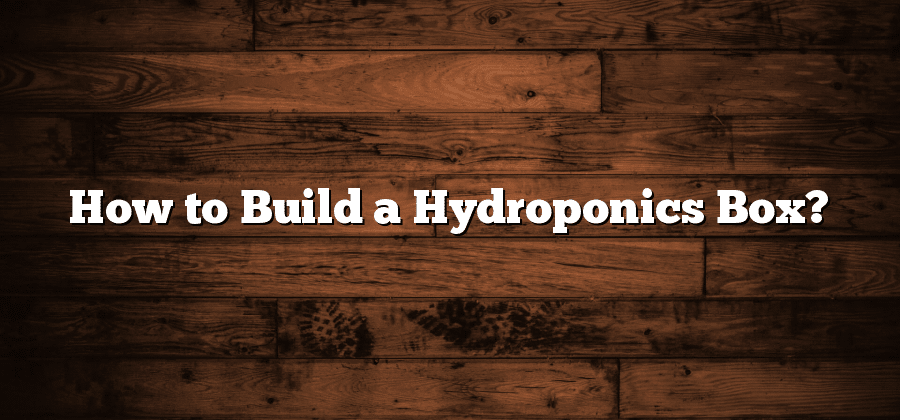Materials Needed for a Hydroponics Box
When it comes to setting up your own hydroponics box, there are a few essential materials that you will need to get started. Firstly, you will need a sturdy and well-built container to house your plants. This can be a plastic tote, a wooden box, or even a PVC pipe structure. The important thing is to choose a container that is large enough to accommodate the number of plants you plan to grow.
Next, you will need a hydroponic system, which includes a nutrient reservoir, a water pump, and a set of growing trays or pots. The nutrient reservoir is where you will mix and store the nutrient solution that will provide the essential elements for your plants’ growth. The water pump will circulate the nutrient solution through the system, ensuring that each plant receives an equal amount of nutrients. Finally, the growing trays or pots will hold the plants, allowing their roots to come into contact with the nutrient solution. These materials are the foundation of a successful hydroponics box, so it is important to choose high-quality and durable options for long-term use.
Design Considerations for a Hydroponics Box
When designing a hydroponics box, there are several key considerations to keep in mind. Firstly, you need to think about the size of the box and how many plants you want to grow. This will determine the dimensions and capacity needed for the box. Additionally, you should consider the type of plants you want to cultivate, as different crops have varying space requirements and nutrient needs.
Another important factor to consider is the material used for the box. It is crucial to choose a material that is resistant to water, as the hydroponics system requires a constant supply of moisture. Additionally, the material should be durable and able to withstand the weight of the plants and equipment. Common materials for hydroponics boxes include plastic, wood, and metal. Each material has its own pros and cons, so it is essential to assess your specific needs and choose accordingly.
Choosing the Right Location for Your Hydroponics Box
When it comes to setting up your hydroponics box, choosing the right location is crucial for its success. The location will determine whether your plants receive the optimal amount of light, temperature, and ventilation they need to thrive. Here are a few key considerations to keep in mind when selecting the perfect spot for your hydroponics box.
First and foremost, you want to find an area with abundant natural light. Ideally, your hydroponics box should be placed near a window or in a room that receives plenty of sunlight throughout the day. This will provide your plants with the necessary energy for photosynthesis and promote healthy growth. Additionally, consider the temperature of the chosen location. Hydroponics boxes thrive in temperatures between 65°F and 75°F, so avoid areas that are too hot or too cold. Furthermore, ensure that the location offers ample ventilation to prevent stagnant air, which can lead to mold growth and poor plant development. By carefully selecting the right location for your hydroponics box, you are setting yourself up for a successful and productive gardening experience.
Setting Up the Frame for Your Hydroponics Box
Once you have gathered all the necessary materials for your hydroponics box, it’s time to start setting up the frame. The frame is the foundation of your box and will provide support for all the components of your hydroponic system. To ensure stability and durability, it is important to choose the right materials for your frame.
One of the most commonly used materials for building hydroponics box frames is PVC pipes. PVC pipes are lightweight, affordable, and easy to work with. They are also resistant to water and other environmental factors, making them an ideal choice for a hydroponics box. When setting up the frame, make sure to measure and cut the PVC pipes accurately to get the desired dimensions. Connect the pipes using PVC connectors or adhesive for a strong and secure frame. Remember to reinforce the corners of the frame with additional fittings or brackets to add stability. Once the frame is complete, double-check that it is level and square before proceeding to the next step.
Installing the Lighting System in Your Hydroponics Box
Once the frame for your hydroponics box is set up and you have chosen a suitable location, it is time to install the lighting system. Proper lighting is crucial for the successful growth of plants in a hydroponics setup.
Firstly, you need to decide on the type of lighting system that best suits your needs. There are various options available, such as fluorescent lights, high-intensity discharge (HID) lights, and light-emitting diode (LED) lights. Each type has its own advantages and disadvantages, so it is important to do some research and consider factors such as energy efficiency, cost, and the specific needs of the plants you plan to grow. Once you have made a decision, you can start installing the lighting fixtures in your hydroponics box.
Next, you will need to position the lights properly to ensure even distribution of light throughout the growing area. The distance between the plants and the lights is also crucial, as it affects the intensity of light received by the plants. Generally, lights should be placed at a distance that allows for optimal coverage without causing any heat stress or burning of the plants. It is recommended to consult the manufacturer’s guidelines or seek advice from experts in hydroponics to determine the best placement and height for your specific lighting system.
Installing the lighting system in your hydroponics box is a critical step in creating the ideal growing environment for your plants. With the right choice of lighting and proper positioning, you can provide your plants with the optimal amount of light needed for photosynthesis and healthy growth.






